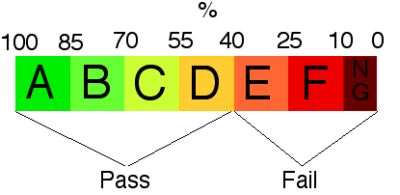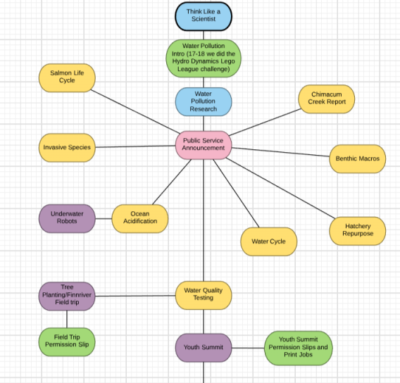I have always said and I continue to share that if you are going to start gamifying your courses and want to take one small step, start with XP. The way experience points, or XP, work in gaming makes for a decent way to grade our students. Here’s the main difference between traditional grading and gaining XP in a game or course. In a traditional classroom you start on day one with a A. 100%! But here’s the catch, as you learn NEW things any mistake you make, you score 70% on your first assignment and maybe get an 80% on your first quiz or heaven forbid you get much lower score and no matter how well you learn the material, even if you get a 100% on the final exam, your overall grade is averaged with all your previous learning attempts! You have to do EXTRA work to get back to that 100% A+. That is not right, it’s malpractice! If you learned and even mastered the material, should your overall score be lowered because you made mistakes during the learning process???
Now here’s what happens in a gamified classroom: you start the course with a ZERO. You have no XP because you haven’t done anything yet! Now as you learn and make mistakes in games, you still get the full XP once you figure out how that level works. The application of that concept to grading is that once your students learn the concept, give them the full XP! Why penalize them for learning along with way to mastery?? So as your students progress in your class they will NOT fear making mistakes because they know they will get full credit ONCE THEY SHOW THEY HAVE LEARNED the concept! That is so much more decent and empowers learners instead of penalizing them for taking time to learn. I can’t tell you how many times I have to try a level over and over again in some games and once I finally gained the skills and expertise to beat that level, I move on with all the XP, actually sometimes more depending on the game, than someone who beat it on their first try. The idea here is to give points once the level, or assignment or unit, is completed reflected how the student actually did! This actually goes hand-in-hand with Standards-Based Grading (SBG) because scores are NOT averaged (or they shouldn’t be IMHO). If you were guaranteed full credit for a course on a topic that is new to you, wouldn’t you take more risks knowing that mistakes will NOT count against you?
I recently got an email from a participant in a gamification workshop I co-presented asking about tying XP to grades. She wrote, “I have been trying to wrap my head around how to tie XP to grades, and what that scale looks like with a percentage system vs. standards based grading. Thoughts?”
I thought I’d share my response here (I re-read my actual response and I’m ashamed to say that what follows is actually more complete than my original response! Sorry!):
Even though I haven’t done traditional grading since I went gradeless in 2010, and after that I went to standards-based grading, I have some ideas of how I would do it, based on Lee Sheldon’s book, The Multiplayer Classroom. Truth be told, my middle school is going back to traditional grades this year after being a standards-based grading school for the past four years and frankly I’m going to continue grading the way I have been because whether I give students 1’s and 3’s or F’s and A’s, the way I assess them and monitor their learning won’t change. We still focus on the NGSS standards so I think I can easily swing it. And since standards-based grading goes strictly by the evidence of whether or not a student shows understanding of the standards, the number of points they have don’t matter to me since I’m reporting whether they got it or not. A kid can have full points and still not do well on a summative assessment because she might not really get it when asked to think about it on her own. So I use XP points in my classes to determine whether or not students are completing quests and keeping up only. I don’t base their final report card scores on those points. So even though I keep track of XP I don’t base a student’s final score on report cards solely on the number of XP he or she has. If the evidence points to a 3, or now an A, then I will give that student a 3 or an A regardless of how much XP he or she has. That is a more accurate reporting of what the student knows because it leaves out the behavior of doing or not doing work out of the score. We have separate scores for behavior so students who do work get a 3 or an A for completing work while another student will get a 1 or an F for not doing any work.
That being said, if I HAD to use traditional grading percentages to report student progress and sort students (and I pray I am never asked to do that again!), here’s what I would do:
- Assign points to all my assignments, activities, labs, quizzes, tests, etc.
- Add all those points up.
- Since not all assignments are essential or necessary, and not all assignments are created equal, and formative assessments are more like practice anyway, I will determine either by unit or all together, how much XP or total points students will need to fully pass my course. Student DO NOT need to get ALL the available XP to pass the course! This part is essential. I might even need to determine a total number of XP by quarter depending on how often I have to report progress on my students. (I’ll explain more on this in a bit.)
- I then make that total from step 3, my “winning condition.” Once students get that many XP, they have passed my course with an A. For kids who get more XP, I will have an A+ if my reporting system allows that. Our Skyward doesn’t do A+ (I don’t really know why) so I would give the student an A then in the comments state that she really got an A+.
- Then I will work my way down from that A to determine how much XP students need for an A-, a B+, a B, a B-, etc.
- I might consider, as in video games, to make “leveling up” from a zero XP F to a D with fewer XP than going from a D to a C-, and that D to C- being done with fewer XP than going from a C- to a C. Going from an A- to an A could have the most XP. This is just a idea, I don’t have to mimic games that strictly. I could make each advancement equal the same amount of XP if I want it to be easier. Not exactly sure how I would do that.
Hopefully, that makes sense. You will end up with students starting the year with zero XP and the more work they do, no matter how many times they have to redo any piece of work, they can get the full XP. That is important, students need to know that they can get more XP if they do and/or redo assignments. If you want to get very detailed, which will make much more work for you, you can give students partial XP for not completing assignments well. I didn’t do that. Students did NOT receive XP for assignments until they were approved satisfactorily by me. That didn’t mean that every student had to do every assignment at the same level. I was able to differentiate based on student needs.
So the only hiccup with this system, back to what I wrote on step 3, is that your students won’t have B’s or A’s until the end of the year for a full year course! Parents won’t understand that! LoL So if you have to have report cards once a quarter, like me, you will need to have an idea of how much XP will be an A, B, C, etc each quarter! So instead of determining your “winning condition” for the whole year, you might want to do it by unit and/or by grading period.
Let me know if you have any more questions or need clarification because I have never actually had to do it that way. Rezzly did it all for me once I inputted all my assignments and determined how much XP each assignment was worth. The goal is that students don’t have to complete ALL my assignments to beat the course and get an A because the spirit of Quest-Based Learning or QBL is that students be given choice as to what type of assignments they can do per concept or standard to show mastery or learning.























































